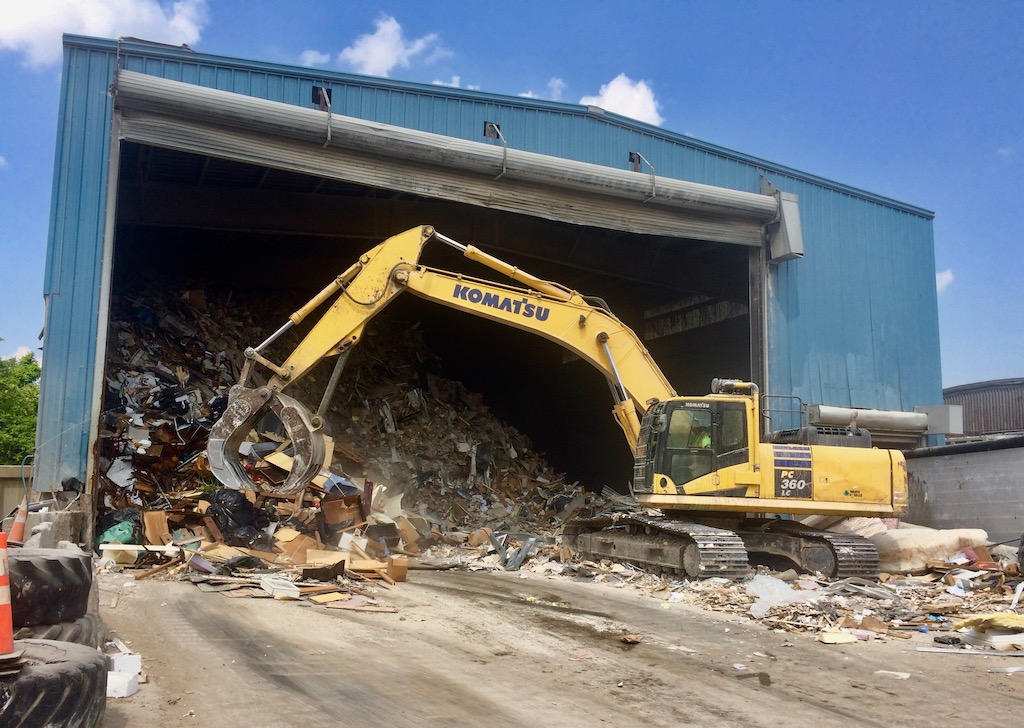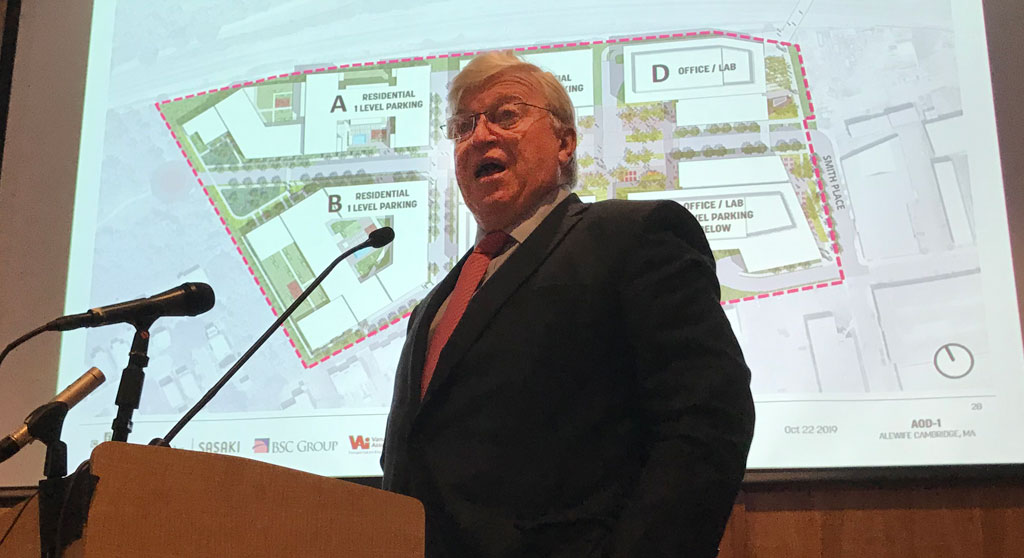Alewife plan makes bridge look possible at last … then makes clear need for second structure (update)

Jay Doherty, chief executive of Cabot, Cabot & Forbes, presents an Alewife area zoning proposal Tuesday to the Planning Board. (Photo: Marc Levy)
Though a proposal to rezone 26 acres in Alewife didn’t have enough detail to draw a Planning Board decision Tuesday – and it’s unlikely city councillors will feel much different Wednesday – there was one part of the project that stood out as solid: a pedestrian bridge over railroad tracks, even if that bridge is not in the ideal location.
Board members quizzed developer Cabot, Cabot & Forbes about a zoning proposal that felt “not even half-baked” (in the words of chair Catherine Preston Connolly), on whether a bridge would happen without its granting (by associate member Nikolas Bowie). Yet there was cause for optimism for a project urged at least as far back as 1979.
“I struggled with that,” Bowie was answered by company chief executive Jay Doherty, who noted he represents investors who might want to fulfill their obligation to existing zoning with a bridge contribution rather than bridge construction. But, Doherty said, “I’m not really interested in contributions – I’m interested in getting things done. I think it deserves to be done, and I think we have found a way to get a bridge done.”
“We’re deeply committed to the construction of a bridge,” Doherty said.

Mooney Street in the Alewife “Quadrangle” area, seen in August 2017, includes industrial uses such as gravel and sand, demolition and trucking businesses. (Photo: Marc Levy)
In the proposal before the board, and coming to the Ordinance Committee of the City Council on Wednesday, the bridge leads to amenities such as restaurants, a test kitchen, craft brewery, climbing club and gym – Evolve Fitness, which faces displacement from development not far away on New Street – made possible by 20-foot ground-floor ceilings. Having those ceilings relies on the granting of overall building heights of up to 85 feet, the developer says. Also made possible: top-dollar lab space in the stories above, also made possible by higher ceilings.
Cabot, Cabot & Forbes bought the land in August 2018 for $79 million. The proposal extends beyond its own 11.9 acres around Mooney Street in the so-called Quadrangle area of Alewife to include neighbors such as the West Cambridge Science Park. It would replace industrial uses such as what is now on Mooney Street, including Mabardy Sand & Gravel, demolition and trucking. Mooney Street would be raised, and its buildings would have water storage underneath to handle expected flooding worsened by climate change.
There would also be room for civic uses such a branch library or fire station, Doherty said.
Though there were concerns with how well the plan fit in with the previous years’ planning process for the area, neighbors who spoke were generally approving of the described amenities.
“As was presented, we’re building on what is warehouse space, a waste transfer station and so forth. I’m really excited for the opportunity to have commercial amenities, the kinds of ‘third places’ where neighbors can meet one another – anything that would help us to sort of come together as neighbors,” said Alisa Lemberg, of Loomis Street.
Doherty warned the board that the vision depended on the granting of taller nonresidential buildings described in the zoning proposal. “It becomes very, very difficult to accomplish that with a 55-foot limitation,” he said.
Looking to a second bridge
Zoning or not, the promise of a bridge has its shortcomings. For years the idea has been to give residents and commuters easy access to and from the Alewife T station, allowing them to skip the area’s intense car traffic and instead make good time on bike, or by foot. But the Quadrangle land in the proposal is far to the west, and its bridge to the “Triangle” area above the tracks would be far enough from the station that Doherty raised the prospect of shuttles.
“There’s no one location that’s going to work all by itself,” board member Hugh Russell said. “This just makes it perfectly clear that this is a great location for one bridge and another one is needed 1,000 feet inbound.”
Board member H Theodore Cohen wondered – “considering how long we’ve been trying to get one” – whether there was any hope for a second bridge. The Community Development Department’s Jeff Roberts noted that Alewife developers on both side of the rail tracks have long been required to set aside property for bridge landing spots, but that a second bridge incorporating a potential new commuter rail stop would “require a lot broader buy-in from the city.”
A three- to four-year time frame was mentioned for the span. On the one hand, Doherty said the bridge he offered was relatively far along because Cabot, Cabot & Forbes had been joined in talks by the MBTA and Cambridge’s city manager – but he lowered hopes of city “buy-in” with an exploration of how bridge ownership would work, given that City Manager Louis A. DePasquale had expressed to him little interest in it becoming a municipal responsibility. (In 2017, city managers had an Alewife bridge omitted from planning despite calls for it from an Alewife Working Group and some city councillors.)
That nettled Russell.
“The bridge ought to be owned by the City of Cambridge,” he said. “What’s a city for? To do what individuals cannot.”
Alewife District Plan arrives – just
There were board concerns over the lack of details in the proposed zoning – associate member Corinne Espinoza in particular homed in on imprecise language, albeit most likely to be handled by the City Council in a letter of commitment, not with the board in zoning. But the biggest stumbling block for the proposal was that a long-awaited Alewife District Plan was posted Tuesday, several months after the Envision Cambridge master planning process had wrapped up but only hours before Cabot, Cabot & Forbes arrived to make its pitch.
“There is a plan that we haven’t had a chance to even have the staff analyze [to see] how this matches,” said Connolly, who, as part of the Envision process, saw some parts that reflected the planning she recalled and other parts that did not. “It has not been synced up.”
Envision as a whole has just short of 200 proposals that have not been heard, and Alewife was always intended to be the first thing that emerged from the process – yet Roberts began the meeting with an extensive list of zoning petitions the board would have to wrestle with in coming months, probably without Envision contributing a structure. Cambridge’s hodgepodge of small zoning patches drew a critique from Bowie: “The way that the zoning map looks like now, it’s just a bunch of squares and overlapping quadrangles of various colors as opposed to what you’d imagine a well-thought-out city would look like. That’s not new; that’s on the past hundred years of zoning.”
Connolly didn’t seem eager to rush in to create more patches. “We have so many zoning petitions coming before us that I am hesitant to keep having the planning board do the work of making them right,” she said. “Having people come back to us again and again and again to try to get it to be something that we can recommend, that’s a burden on staff, it’s a burden on the Planning Board and ultimately it’s is not fair to the community, either.”
The Cabot, Cabot & Forbes proposal was continued to a future meeting.
Update on Oct. 23, 2019: Councillors who heard the Cabot, Cabot & Forbes presentation Wednesday agreed with the Planning Board: The zoning proposal needs a lot of work, including many more specifics. A bridge across Alewife train tracks remained prominent in discussion – councillor Craig Kelley called it “the only one thing I care about”– with the wrinkle that many speakers wanted a bridge big enough to accommodate shuttle buses full of people, not just bikes and pedestrians.
Councillors learned that a bridge is not guaranteed by the proposed zoning, though the developer indicated it would be amenable to conditions that made it so.
Another issue brought up Wednesday by Doherty: The U.S. Postal Service is looking to stay in the Quadrangle and expects to have a large surface parking lot for fleet vehicles, as well as for its employees, he said.
John Hawkinson reported the update to this post.





As a member of the Envision Alewife Working Group, I think it’s important to correct a misrepresentation that this article promotes; namely, the City’s ongoing commitment to constructing a bridge over the tracks. In the article, Cambridge Day quotes the City’s Director of Zoning Jeff Roberts as saying “that a second bridge incorporating a potential new commuter rail stop would ‘require a lot broader buy-in from the city’.” This is inaccurate.
The article is correct that in 2017, an Alewife bridge was omitted from a draft of the Alewife District Plan. Sadly, it fails to mention that this omission was later reversed, and that the City remains on the hook to build a bridge at the eastern end of the Quadrangle. In fact, Cambridge Day itself reported on this reversal in two separate articles last year:
https://www.cambridgeday.com/2018/02/25/alewife-rail-bridge-is-back-as-long-term-goal-but-councillors-are-pushing-for-faster-action/
https://www.cambridgeday.com/2018/04/13/alewife-bridge-could-be-ready-in-2025-funded-by-new-fee-paid-by-developers/
This turnabout on the part of the City administration happened because the entire Alewife Working Group submitted a letter supporting the bridge and objecting to its sudden removal from the Plan by the City’s planning team. The new Alewife District Plan released yesterday is an imperfect document, at least in my opinion, but one thing it is unequivocal about is the need for a bridge, together with a commuter rail stop, at the eastern end of the Quad.
Page 133 of the report states that “The construction of a bicycle and pedestrian bridge connecting the Quadrangle and Triangle subdistricts is an important element to improve access to public transit and within the district.” The report even contains a rendering of the bridge on the very same page (though the rendering has now been modified to eliminate any trace of the also desired Alewife commuter rail station).
Fortunately, the Planning Board appears to understand that this new bridge now proposed by developer Cabot Cabot & Forbes is in no way a substitute for the original bridge to which the City previously committed. In critiquing CC&F’s bridge presentation, Board member Hugh Russell stated that “This just makes it perfectly clear that this is a great location for one bridge and another one is needed 1,000 feet inbound.”
In short, I’m all for CC&F building a bridge to improve connectivity within and across the district for new residents and commuters to their site. That said, such a contribution in no way should be seen as fulfilling the City’s long-standing obligation to build a bridge and rail stop at the opposite end of the Quad to serve the area’s existing residents and commuters. Cambridge Day does us all a disservice when it implies otherwise.